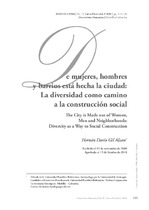| dc.contributor.author | Gil Alzate, Hernán Darío | |
| dc.coverage.spatial | Seccional Medellín | spa |
| dc.date.accessioned | 2021-02-05T16:48:25Z | |
| dc.date.available | 2021-02-05T16:48:25Z | |
| dc.date.issued | 2010 | |
| dc.identifier.uri | http://hdl.handle.net/20.500.11912/7887 | |
| dc.description | p. 115 - 133 | spa |
| dc.description.abstract | El presente texto expone la metodología utilizada por la Antropología en el trabajo de campo a partir de la lectura que se puede hacer de los fenómenos socio-culturales en comunidades. Así se pretende mostrar que la investigación logra adentrarse en los espacios de ciudad, barrio y casa como elementos estructurantes de un individuo que fortalece sus relaciones con “otros que lo acompañan” en el quehacer humano. La esencia biológica del ser se une a la forma comportamental de los individuos en una sociedad y en las unidades más íntimas de la relación de seres corporales pero también sociales. El proceso de hominización y de humanización se plasma en la vida cultural. Un sujeto que se lee a sí mismo se hace visible en la comprensión de su entorno cultural. | spa |
| dc.description.abstract | This paper shows the methodology used by Anthropology in the field work, from the interpretation that can be made of socio-cultural phenomena in different communities. We intend to show that research does go into the spaces of the city, the neighborhood and the house, as structural elements of the individual that strengthen his relationships with others who assist him in human affairs. The behavior of individuals in a society and on the most intimate relationship of corporeal beings, but also social beings, adds to the biological essence of being human. The process of hominization and humanization is reflected in cultural life. A subject that reads himself is visible in the understanding of his cultural environment. | spa |
| dc.format.mimetype | application/pdf | |
| dc.language.iso | spa | |
| dc.publisher | Universidad Pontificia Bolivariana | spa |
| dc.relation.ispartof | Pensamiento humanista | spa |
| dc.rights | Attribution-NonCommercial-NoDerivatives 4.0 International | * |
| dc.rights.uri | http://creativecommons.org/licenses/by-nc-nd/4.0/ | * |
| dc.subject | Antropología Cultural | spa |
| dc.subject | Etnografía | spa |
| dc.subject | Biología | spa |
| dc.subject | Sociedad y Cultura | spa |
| dc.subject | Espacio Vital | spa |
| dc.subject | Cultural Anthropology | spa |
| dc.subject | Ethnograpy | spa |
| dc.subject | Biology | spa |
| dc.subject | Society and Culture | spa |
| dc.subject | Vital Space | spa |
| dc.title | De mujeres, hombres y barrios está hecha la ciudad: La diversidad como camino a la construcción social | spa |
| dc.title.alternative | The City is Made out of Women, Men and Neighborhoods: Diversity as a Way to Social Construction | spa |
| dc.type | article | spa |
| dc.rights.accessRights | openAccess | spa |
| dc.type.hasVersion | publishedVersion | spa |
| dc.description.sectional | Medellín | spa |
| dc.identifier.instname | instname:Universidad Pontificia Bolivariana | spa |
| dc.identifier.reponame | reponame:Repositorio Institucional de la Universidad Pontificia Bolivariana | spa |
| dc.identifier.repourl | repourl:https://repository.unab.edu.co/ | |


